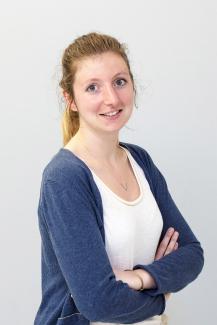Mélissa Vincent: Doctoral student in biomedical imaging
Mélissa Vincent is in the fourth year of her thesis at the Molecular Imaging Research Center (MIRCen - Université Paris-Saclay, CEA). Her thesis is on the "diffusion-weighted in vivo NMR spectroscopy to probe alterations in cell structure in a neuropathological context". She is going to spend four months at Chaumeil Lab at the University of California, San Francisco, working on her project.
Tell us about the subject of your thesis.
The brain is made up of different molecules. Traditionally, medical magnetic resonance imaging (MRI) allows us to detect water molecules. But, with nuclear magnetic resonance (NMR) spectroscopy, it is possible to observe other molecules, such as metabolites, which are specifically present in certain brain cells.
The goal of my thesis is to detect the diffusion of metabolites in the brain by performing original measurements in NMR spectroscopy and, from this information, to determine the microstructure of brain cells.
During my exchange in the U.S., I will concentrate particularly on lactate and its cerebral distribution. One of the hypotheses concerning this metabolite is that during brain activity, it is transported from the glial cells to the neurons in order to supply them with energy. If this proves to be true, lactate plays an important role in cerebral metabolism; however, the tools are lacking to accurately pinpoint the metabolites.
Thanks to the methods developed within my team, I will be able to follow the diffusion of lactate in vivo to better understand its distribution and therefore its function in neuronal activity.
Why go to the U.S.? In what way will this further your thesis?
At the moment, the tools we have developed to track lactate are not sensitive enough to detect its weak signal. By combining our work with the knowledge developed at Chaumeil Lab, we hope to amplify this signal and achieve more precise measurements.
I chose the United States, and this laboratory in particular, because we have the most professional contacts with them outside France. The director of Chaumeil Lab, who completed her doctorate at the Frédéric Joliot Hospital Service (SHFJ - Université Paris-Saclay, CEA), maintains a strong relationship with my laboratory and takes in a number of MIRCen doctoral students for post-doctoral studies. The work carried out there also covers subjects similar to the one I am studying in my thesis. It therefore seemed quite natural that I should decide to continue my research there.
What do you hope to learn or discover?
Thanks to the Fulbright programme, I have the chance to advance my thesis project by conducting experiments that simply cannot be performed at MIRCen. This initiative also stems from a personal desire to have another experience abroad: during my studies, I spent three years in England conducting research in the field of biomedical engineering.
These four months will give me the opportunity to discover how the world of research works in America. Working with a new laboratory will boost my professional project since I will learn new techniques and, above all, acquire new perspectives on my studies.

